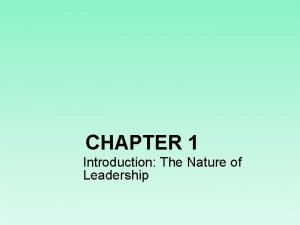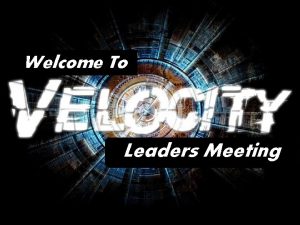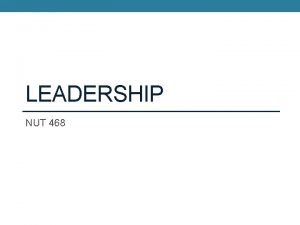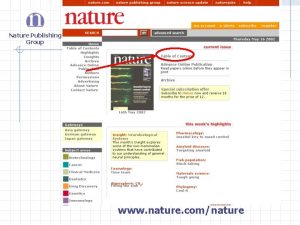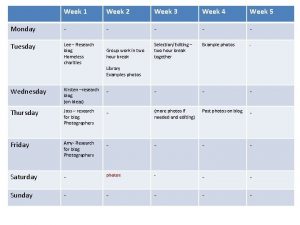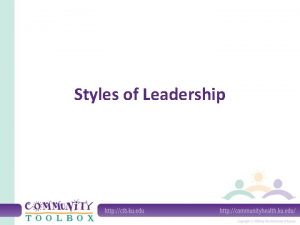Leadership Week 11 The Nature of Leadership Leaders


























- Slides: 26

Leadership Week 11

The Nature of Leadership • Leaders make a difference, they are key to organizational success • People, influence, and goals – Relationship with people is not passive – Leadership is reciprocal among people – Leadership is the ability to influence people toward the attainment of goals Copyright © 2013 by South-Western, a division of Cengage Learning. All rights reserved.

Contemporary Leadership • Leadership evolves with the needs of the organization • Leadership has evolved with technology, economic, labor, social and cultural changes • Must respond to the turbulence and uncertainty of the environment – Ethical and economic difficulties as well as globalization Copyright © 2013 by South-Western, a division of Cengage Learning. All rights reserved.

Level 5 Leadership Level 5 leadership refers to the highest level in a hierarchy of manager capabilities – Lack of ego (humility) – Fierce resolve to do what is best (will) – Give credit to other people – Ambitious for the company Copyright © 2013 by South-Western, a division of Cengage Learning. All rights reserved.

Level 5 Hierarchy Copyright © 2013 by South-Western, a division of Cengage Learning. All rights reserved.

Servant Leadership • Transcend self-interest for the good of the organization • Leadership is not about YOU • Workers should be developed • Servant leaders give away power, ideas, information, recognition, credit for accomplishments, even money Copyright © 2013 by South-Western, a division of Cengage Learning. All rights reserved.

Authentic Leadership ü ü ü Leaders who know themselves Consistent with higher order ethical values Empower and inspire others Open and authentic Inspire trust and authenticity Encourage collaboration and help others grow Copyright © 2013 by South-Western, a division of Cengage Learning. All rights reserved.

Components of Authentic Leadership Copyright © 2013 by South-Western, a division of Cengage Learning. All rights reserved.

Gender Differences ü Derived from studies of women leaders ü Minimizing personal ambition ü Developing others ü Consensual and collaborative; interactive leadership ü Influence derived from relationships Copyright © 2013 by South-Western, a division of Cengage Learning. All rights reserved.

Gender Differences in Leadership Behaviors Source: Data from Hagberg Consulting Group, Management Research Group, Lawrence A. Pfaff, Personnel Decisions International Inc. , Advanced Teamware Inc. , as reported in Rochelle Sharpe, “As Leaders, Women Rule, ” Business. Week (November 20, 2000): 75 -84. Copyright © 2013 by South-Western, a division of Cengage Learning. All rights reserved.

From Management to Leadership Ø Good management is essential to organizations Ø But, good managers must be leaders Ø Management promotes stability, order, and problem solving Ø Leadership motivates toward changing challenges Ø Leadership cannot replace management, there should be a balance of both Copyright © 2013 by South-Western, a division of Cengage Learning. All rights reserved.

Leader and Manager Qualities Copyright © 2013 by South-Western, a division of Cengage Learning. All rights reserved.

Leadership Traits • Early research on leadership focused on traits • Interest in examining leadership traits has reemerged • Some traits that are considered positive can have negative consequences • The best leaders understand their traits and hone their strengths Copyright © 2013 by South-Western, a division of Cengage Learning. All rights reserved.

Personal Characteristics of Leaders Copyright © 2013 by South-Western, a division of Cengage Learning. All rights reserved.

Behavioral Approaches • Research beyond leadership traits, defined two leadership behaviors: – Task-oriented behavior – People-oriented behavior • Ohio State studies identified two major behaviors: – Consideration; people oriented – Initiating structure; task behavior • Michigan Studies compared behavior – Employee-centered leaders (most effective) – Job-centered leaders (not effective) Copyright © 2013 by South-Western, a division of Cengage Learning. All rights reserved.

Contingency Approaches • How do situations influence a leader’s effectiveness? – Hersey and Blanchard (situational) – Leadership Model (Fiedler) – Substitutes for leadership concept Copyright © 2013 by South-Western, a division of Cengage Learning. All rights reserved.

The Situational Model of Leadership • Extension of behavioral theories • Focus on characteristics of followers • Seek appropriate leadership behavior • Leadership is based on relationship with followers and readiness level of followers Copyright © 2013 by South-Western, a division of Cengage Learning. All rights reserved.

The Situational Model of Leadership Copyright © 2013 by South-Western, a division of Cengage Learning. All rights reserved.

Fiedler’s Contingency Theory • Leader’s style is task oriented or relationship oriented – Relatively fixed • Goal is to match the leader’s style with organizational situation • Analyze the leaders’ style to the favorability of the situation Copyright © 2013 by South-Western, a division of Cengage Learning. All rights reserved.

Substitutes for Leadership ü There are situations where leader style is unimportant ü There are situations and variables that can substitute or neutralize leadership characteristics Copyright © 2013 by South-Western, a division of Cengage Learning. All rights reserved.

Charismatic and Visionary Leadership • Charismatic leaders are skilled in the art of visionary leadership – Vision is an attractive, ideal future • Inspire and motivate people to do more – A lofty vision, “ a fire that ignites followers” – Ability to understand empathize – Empowering and trusting subordinates • Visionary leaders speak to the hearts of employees to be a part of something big Copyright © 2013 by South-Western, a division of Cengage Learning. All rights reserved.

Transformational versus Transactional Leadership Transactional Transformational – Clarify tasks – Initiate structure – Provide awards – Improve productivity – Hardworking – Tolerant & fair-minded – Focus on management – Innovative – Recognize followers’ needs – Inspire followers – Create a better future – Promote significant change Copyright © 2013 by South-Western, a division of Cengage Learning. All rights reserved.

Followership • Organizations do not exist without followers • Leaders must understand their followers – Alienated follower – Conformist – Pragmatic survivor – Passive follower – Effective follower • Is the follower active or passive? Copyright © 2013 by South-Western, a division of Cengage Learning. All rights reserved.

Styles of Followership Copyright © 2013 by South-Western, a division of Cengage Learning. All rights reserved.

Power and Influence • Position Power – Legitimate Power – Reward Power – Coercive Power • Personal Power – Expert Power – Referent Power Both leaders and followers use power to get things done • Other Sources of Power – Personal Effort – Network of Relationships – Information Copyright © 2013 by South-Western, a division of Cengage Learning. All rights reserved.

Seven Interpersonal Influence Tactics for Leaders Copyright © 2013 by South-Western, a division of Cengage Learning. All rights reserved.
 Week by week plans for documenting children's development
Week by week plans for documenting children's development Unit 5 wonders of nature week 1
Unit 5 wonders of nature week 1 Nature and nature's laws lay hid in night meaning
Nature and nature's laws lay hid in night meaning Determinace lidské psychiky
Determinace lidské psychiky Classical leadership
Classical leadership Nature of leadership
Nature of leadership Nature of leadership
Nature of leadership Nature of leadership
Nature of leadership Nature of leadership
Nature of leadership Dạng đột biến một nhiễm là
Dạng đột biến một nhiễm là Bổ thể
Bổ thể Vẽ hình chiếu đứng bằng cạnh của vật thể
Vẽ hình chiếu đứng bằng cạnh của vật thể độ dài liên kết
độ dài liên kết Các môn thể thao bắt đầu bằng tiếng chạy
Các môn thể thao bắt đầu bằng tiếng chạy Thiếu nhi thế giới liên hoan
Thiếu nhi thế giới liên hoan Sự nuôi và dạy con của hổ
Sự nuôi và dạy con của hổ điện thế nghỉ
điện thế nghỉ Một số thể thơ truyền thống
Một số thể thơ truyền thống Nguyên nhân của sự mỏi cơ sinh 8
Nguyên nhân của sự mỏi cơ sinh 8 Trời xanh đây là của chúng ta thể thơ
Trời xanh đây là của chúng ta thể thơ Các số nguyên tố là gì
Các số nguyên tố là gì Vẽ hình chiếu vuông góc của vật thể sau
Vẽ hình chiếu vuông góc của vật thể sau Tỉ lệ cơ thể trẻ em
Tỉ lệ cơ thể trẻ em Các châu lục và đại dương trên thế giới
Các châu lục và đại dương trên thế giới Thế nào là hệ số cao nhất
Thế nào là hệ số cao nhất Hệ hô hấp
Hệ hô hấp Tư thế ngồi viết
Tư thế ngồi viết








